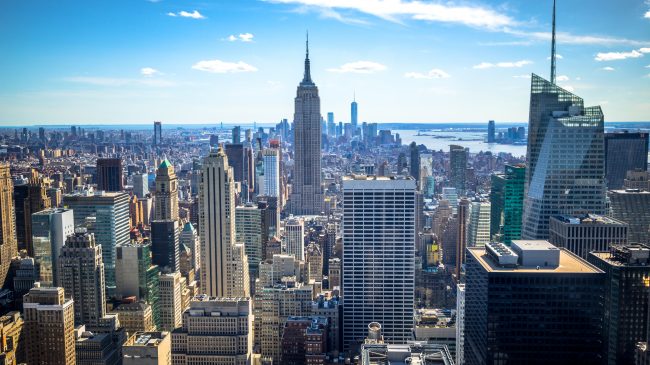Next year, New York City is expected to begin using congestion pricing to help manage demand for Manhattan’s gridlocked roads, as well as raise revenue to fund transportation projects. Unfortunately, New York City plans to divert most of that new revenue from the congested roads that generate it to mass transit projects, which will shift the bulk of benefits of congestion pricing away from the users who pay them to those who bear none of the costs.
With over 1.6 million commuters daily and speeds that can average less than five miles per hour, Manhattan’s chronic traffic problems could be reduced by the city’s congestion pricing plan. After its implementation, the congestion pilot program is set to charge cars and trucks traveling south of 60th Street, with exemptions made for buses, taxis, for-hire vehicles, emergency vehicles, and vehicles with disabled parking plates. In theory, the charge could reduce peak-hour traffic congestion on some of Manhattan’s busiest roadways.
The Westside Highway and FDR Drive, which circle the island and provide access to the outer boroughs, will not be subjected to the congestion pricing.
While the exact rate is yet to be determined, the Traffic Mobility Review Board (TMRB) is considering a peak-period congestion charge for cars of up to $9.18 and up to $22.95 for trucks. A plan that was primarily focused on improved mobility rather than simply raising revenue would set a lower charge. For example, the congestion pricing proposal being considered in Seattle has a much lower rate. While the cost of living is higher and traffic congestion is certainly worse in New York City than Seattle, the difference in congestion pricing is much greater than the difference in congestion.
The TMRB prefers a variable pricing approach where the congestion pricing charges would be highest when demand on the roads is highest, providing a monetary incentive for commuters to avoid driving when the city is most prone to congestion. This makes sense. Unfortunately, the main focus of TMRB seems to be to guarantee that congestion pricing revenue produces at least $1 billion a year, an amount that would allow the Metropolitan Transportation Authority (MTA) to secure $15 billion in revenue bonds by 2024.
The MTA plans to use $15 billion in bonds to modernize New York’s public transit system. Eighty percent of revenue collected from the congestion pricing would be allocated toward transit within the city, specifically the New York City Subway, Staten Island Railway and MTA regional bus operations. The remaining 20 percent would be allocated to commuter rail, equally split between the Long Island Railroad and Metro-North commuter rail.
Thus, congestion pricing revenue would primarily benefit New Yorkers who use the public transportation system. While commuters who drive or take the bus would ideally see the benefit of decreased traffic below 60th Street, some commuters may have to switch their commute times to avoid the charges or use public transit.
Over the long-term, the congestion pricing revenue is likely to benefit transit commuters, especially those who live near a subway station in the city or a train station on Long Island, Staten Island or in Connecticut. Westchester County’s Bee-Line Transit Buses, however, go only as far as the Bronx so they aren’t expected to see any benefits, like decreased traffic congestion or increased funding. More troubling, if congestion pricing raises demand for transit there will be no revenue to address the increased demand on public transit in New Jersey.
Even New Jerseyans who already avoid driving into Manhattan face additional financial barriers when compared to commuters on the other side of the river. The price of a ticket for a 1.5-mile ferry ride from New Jersey to Midtown is $8.00 one way, while parking at the ferry terminal is $20.00 for the day. A five-mile ride on the Staten Island Ferry is free and parking costs $8.00 for 18 hours. Furthermore, the 14-mile Staten Island Railway connects the length of the island to the ferry terminal and charges only $2.75 each way. A similar 15 mile NJ Transit train ride from Fairlawn, NJ, to Penn Station costs $7.25 each way.
Since New Jersey residents will pay a portion of the congestion pricing fees, they should receive some of the revenue for transit and highway projects. Potentially, revenue could fund projects that provide affordable parking for and decreased congestion around major transit hubs, such as Secaucus Junction, Hoboken, or Newark’s Penn Station. After all, the large concentration of commuters into Midtown Manhattan makes New York more conducive to transit services than anywhere else in the country.
New York’s congestion pricing, furthermore, will serve as an unequal double-charge on some drivers and not others. Currently, drivers from the outer boroughs often pay nothing in tolls to enter Manhattan. The Queensborough, Williamsburg, Manhattan and Brooklyn Bridges, as well as most connections between the Bronx and Manhattan, have no tolls. Drivers from New Jersey pay a one-way $12.50 toll with an E-ZPass or $15.00 in cash to enter New York City on any of the Port Authority’s bridges and tunnels. The charging discrepancy is not simply about size either, as the free-to-use Manhattan Bridge is over 40 percent longer than the George Washington Bridge.
The TMRB’s current plan to address double tolling is to provide an automatic credit for drivers who enter the congestion zone directly from a tolled crossing. Put another way, a driver using the Lincoln Tunnel would spend $12.50 to use the tunnel and only about $3.32 for congestion pricing, while a driver using the non-tolled Brooklyn Bridge would pay $9.18 for the congestion pricing. Drivers who pay a toll to enter Manhattan outside of the congestion zone, like those using the George Washington Bridge, will not be offered a credit.
If New York’s congestion pricing is to successfully alleviate gridlock in Manhattan, TMRB needs to acknowledge that the selective double-charging of users of certain bridges and tunnels could significantly shape the demand for highways and mass transit. Accordingly, drivers who bear both a bridge toll and full congestion pricing deserve to see some of the benefits of the congestion pricing revenue, be it through increased transit or access to parking facilities.
New York’s congestion pricing plan has the potential to alleviate traffic congestion and create better commutes for everyone. To do so, New York should allocate new revenue to projects throughout the New York area fairly, from highway alterations and parking garages to projects that expand the scope of transit options.


